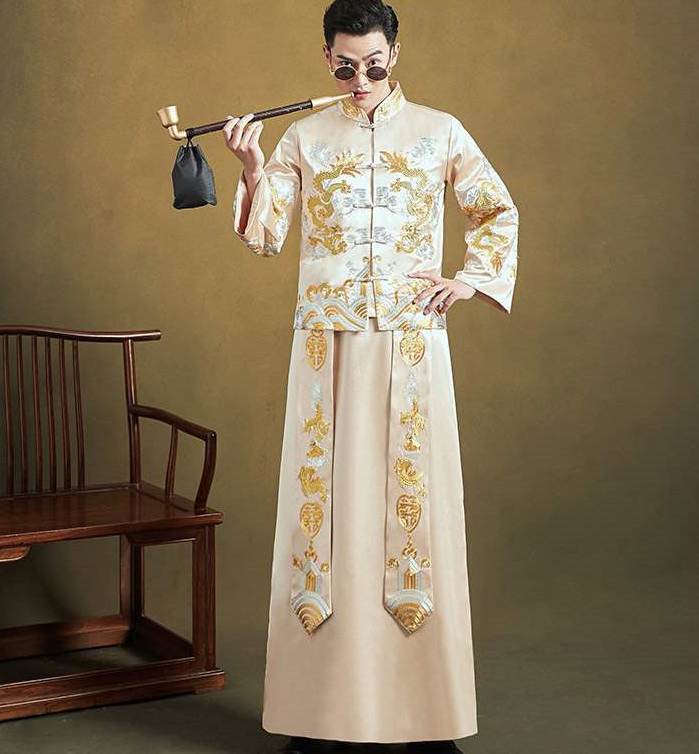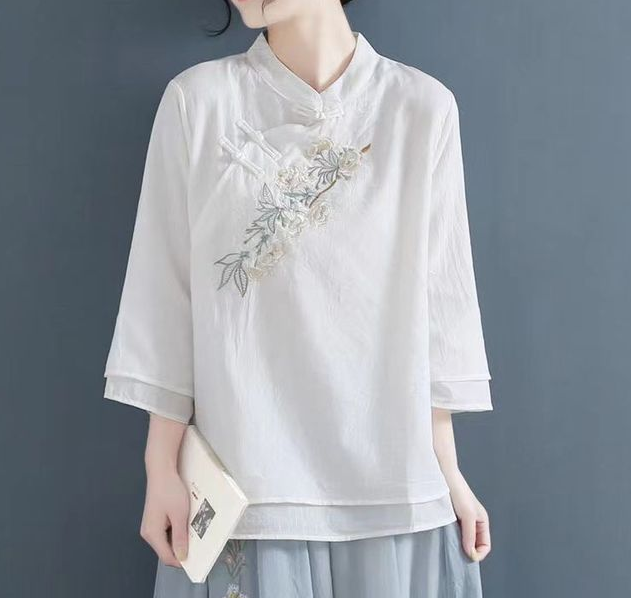A Chinese Tang Suit is a traditional Chinese attire, reflecting cultural values and historic aesthetics.
Origins of the Tang Suit
The Tang Dynasty, which spanned from 618 to 907 AD, is often hailed as the pinnacle of ancient Chinese civilization. During this period, China saw an explosion of culture, arts, science, and particularly fashion. The fashion trends from this period became iconic, laying down the foundation for what would later be known as the “Tang Suit.”

The Tang Dynasty: A golden era for fashion
The Tang Dynasty is renowned for its opulence and cultural renaissance. As trade routes expanded and with the establishment of the Silk Road, China opened its doors to the diverse cultures and goods of Central Asia, Persia, and even Rome. This cross-cultural exchange influenced the clothing styles significantly.
During the Tang Dynasty, clothing was not just a necessity but a reflection of one’s status, wealth, and aesthetic taste. Women’s dresses, known as “Qipao” or “Cheongsam,” were made of silk, showcasing intricate patterns and vivid colors. The common colors were jade green, royal blue, and bright yellow, with gold and silver threads used for embroidery. A high-quality silk Qipao could cost upwards of 50 silver coins, which was quite a significant amount at that time.
Men, on the other hand, wore robes that were more straightforward but equally ornate. The materials used were of high quality, and the designs were meticulously crafted, showcasing the wearer’s social standing.
How the Tang suit evolved over time
As centuries passed, the clothing styles from the Tang Dynasty underwent transformations. By the time of the Qing Dynasty, the Manchu-style clothing became predominant. However, the essence of the Tang Dynasty fashion remained.
During the early 20th century, the Tang suit saw a resurgence, especially among overseas Chinese communities. These modern Tang suits blended the traditional designs of the Tang Dynasty with Western fashion elements. For instance, the length of the dress might have been shortened, or collars were adjusted, but the characteristic silk material and vivid embroidery remained.
In today’s world, the Tang suit, especially the Qipao, has become symbolic of Chinese culture. They are worn during special occasions, festivals, and cultural events. High-quality Tang suits can cost anywhere from $200 to $2000, depending on the material quality and craftsmanship involved.
Design and Characteristics
Tang suits represent a harmonious blend of aesthetics, functionality, and symbolism. The design encapsulates Chinese tradition, reflecting not only the fashion sense of ancient times but also the values and beliefs of Chinese culture.
Distinctive features of a Tang suit
Tang suits are recognizable by their unique cuts, shapes, and decorations. Most traditional Tang suits have a straight collar, and the buttons are usually adorned with intricate designs or motifs. The sleeves are generally full-length, though variations exist, and the suit itself often reaches down to the knees or even the ankles.
The patterns and embroidery on the Tang suit often depict traditional Chinese symbols, such as dragons, phoenixes, or flowers like peonies and chrysanthemums. These symbols have their roots in ancient Chinese myths and tales, and they carry specific meanings, like prosperity, longevity, or good fortune.
Materials commonly used
Silk is the primary material for the Tang suit. The reason for its popularity lies in its quality and the comfort it offers. Silk has a smooth texture, and it’s both lightweight and breathable, making it ideal for wear in various climates. Apart from silk, materials like satin, brocade, and even cotton can be used, depending on the purpose and the wearer’s preference. High-end Tang suits made from premium silk, with meticulous embroidery, can fetch prices upwards of $1500, reflecting the material’s quality and the craftsmanship.
Linen is another material that has been increasingly used in modern Tang suits due to its breathable nature and comfort during the summer months.
The significance of colors and patterns
Colors in Chinese culture are deeply symbolic. In the context of the Tang suit, colors such as red, yellow, and green dominate. Red symbolizes luck and prosperity, making it a favorite choice for events like weddings or Lunar New Year celebrations. Yellow, once reserved for royalty in ancient China, represents power and is often associated with ceremonies and important events.
Patterns on Tang suits, as mentioned earlier, often revolve around iconic Chinese symbols. The dragon, for example, is a symbol of power, strength, and good luck. The phoenix, another popular motif, represents renewal and the eternal cycle of life. Together, a dragon and phoenix design on a Tang suit symbolizes the harmonious union of yin and yang.
Cultural and Symbolic Meanings
Tang suits are not just garments; they are a mirror reflecting the rich tapestry of Chinese culture, history, and tradition. Their design, patterns, and colors go beyond aesthetics, providing insights into the Chinese way of life, their values, beliefs, and aspirations.
The importance of Tang suits in festivals and celebrations
Tang suits play a pivotal role in various Chinese festivals and celebrations. For instance, during the Lunar New Year, also known as Spring Festival, wearing a red Tang suit is considered auspicious. It’s believed to bring luck, ward off evil spirits, and ensure a prosperous year ahead. With nearly 20% of the world’s population celebrating this festival, one can imagine the number of Tang suits worn during this time.
Similarly, Tang suits hold significance in traditional Chinese weddings. In some ceremonies, brides wear a red Qipao, a variant of the Tang suit, symbolizing luck and happiness in their marital journey.
Another festival where Tang suits make a prominent appearance is the Mid-Autumn Festival. Celebrated to honor the moon and family reunions, many choose to don Tang suits as a nod to tradition and togetherness.
Given the importance of these festivals and the vast number of participants, the demand for Tang suits spikes during these periods. High-quality Tang suits, especially those used in weddings, can be expensive, often ranging between $500 to $2000, depending on the intricacy of designs and the quality of materials used.
Symbolism embedded in the designs
Every stitch, pattern, and color on a Tang suit tells a story. For instance, the dragon, a revered symbol in Chinese mythology, represents power, strength, and good fortune. Often, emperors would wear robes adorned with dragon motifs, symbolizing their divine right to rule.
Another symbol commonly found is the lotus flower, representing purity, beauty, and resilience. The bamboo, often depicted in patterns, stands for flexibility, strength, and integrity.
Colors, too, have their tales to tell. As previously mentioned, red is the color of luck and prosperity. Green signifies growth and harmony, while blue stands for healing and trust.
Tang Suits in Modern Day
In the ever-evolving world of fashion, traditions often intersect with modernity, creating unique blends that celebrate heritage while embracing contemporary tastes. The Tang suit, with its deep-rooted history and symbolic significance, has not been left behind in this trend. Today, it continues to inspire and be a part of modern fashion narratives.

Contemporary adaptations of the Tang suit
Modern designers have taken cues from the traditional Tang suit, adapting its timeless designs to fit contemporary aesthetics. These adaptations see a fusion of Eastern and Western styles. For instance, the length of the traditional Qipao has been shortened in some designs to resemble Western-style dresses, making them more suitable for daily wear or semi-formal events.
The materials used have also seen diversification. While silk remains a popular choice, especially for formal Tang suits, designers have incorporated other fabrics like cotton, polyester, and even denim for a more casual look. Depending on the material and design, modern Tang suits can range in price from $100 for simpler designs to over $1500 for high-end, intricate pieces.
Moreover, in recent years, the Tang suit has been reimagined to cater to the youth. Collaborations between traditional Chinese brands and streetwear labels have given birth to Tang suit-inspired jackets, shirts, and even sneakers. These pieces, often limited in edition, can fetch high prices, sometimes going upwards of $500, especially when released by popular streetwear brands.
How Tang suits influence modern fashion trends
The Tang suit’s influence on modern fashion is undeniable. International fashion houses and designers, inspired by the rich tapestry of Chinese culture, often incorporate Tang suit elements into their collections.